1. Overview
A Tale of Two Souls is a narrative-driven, choice-based adventure game set in a dystopian world where humans have seized control over nature, oppressing animals and disrupting the once-harmonious ecosystem. Players take on the roles of Pantheon, a tiger, and Willow, a deer, who embark on a dangerous journey to challenge the oppressive regime and restore balance to the world.
Motivation: I love animals, and I wanted to create an emotionally engaging game that addresses critical real-world issues pertaining to animal cruelty and the extinction crisis.
Role Switching: A key mechanism of the game is that players can alternate between controlling Pantheon and Willow, each with their unique abilities and perspectives. Pantheon embodies strength and agility, while Willow represents grace and resourcefulness. Switching between characters allows players to approach challenges in different ways.
Health Management: Players must be strategic in their choices to ensure the survival of both Pantheon and Willow. Losing all health for one character would lead to the “Failure” ending, where the animals die.
Multiple Endings: The game offers three distinct “Success” endings (Revolution, Exile, and Coexistence), each with a unique resolution to the story, which increases replayability and provides players with meaningful choices that shape the narrative’s outcome. An ending can be reached by triggering a set of events after certain objects or pieces of information have been collected.
2. Link to Final Prototype
Play A Tale of Two Souls at https://kathchen.itch.io/a-tale-of-two-souls
3. Iterations & Playtesting
Iteration 1: Tiny Playable Prototype
This was a crappy prototype made for class 4B. I created a Twine project and developed the opening pages of my interactive narrative. At the beginning, I selected two arbitrary animals, a cat and a puppy, to experiment with the role-switching feature. The game starts with an introductory screen describing a dystopian setting, then allows the player to pick between the cat and the puppy. Then, it presents them with choices when they encounter a group of humans carrying cages.
Click here to view a short video demo of the initial prototype.
| Playtest # | Date | Duration | Playtester | Gender |
| 1 | 10/19/2023 (in class) |
3 minutes | Chinat Jason Elyse |
Male Male Female |
Feedback
All three players liked my premise, images, and the role-switching mechanism. However, Elyse pointed out a dissonance: “Currently, the game feels a bit weird. In the real world, humans love cats and puppies and keep them at home, so it doesn’t make sense why the main characters are marginalized and going through all this.” Jason wanted to see more interaction between the cat and the puppy (e.g. if one dies, the player can switch to the other character and try to save them) and suggested adding a health point system. All three players wanted to know what led to this dystopian world and why the humans are doing this to the animals in the first place.
Changes Made
Since my game was incomplete, it was difficult for players to provide any constructive feedback on the narrative. They were mostly curious about how the story would turn out. Therefore, for the next iteration, I focused on completing one branch (“Success–Revolution” ending) such that the game is playable from beginning to end.

To address Elyse’s feedback, I switched the main characters (the cat and the puppy) to Pantheon, a tiger, and Willow, a deer, as these animals are more likely to be in the wild, endangered, and mistreated.
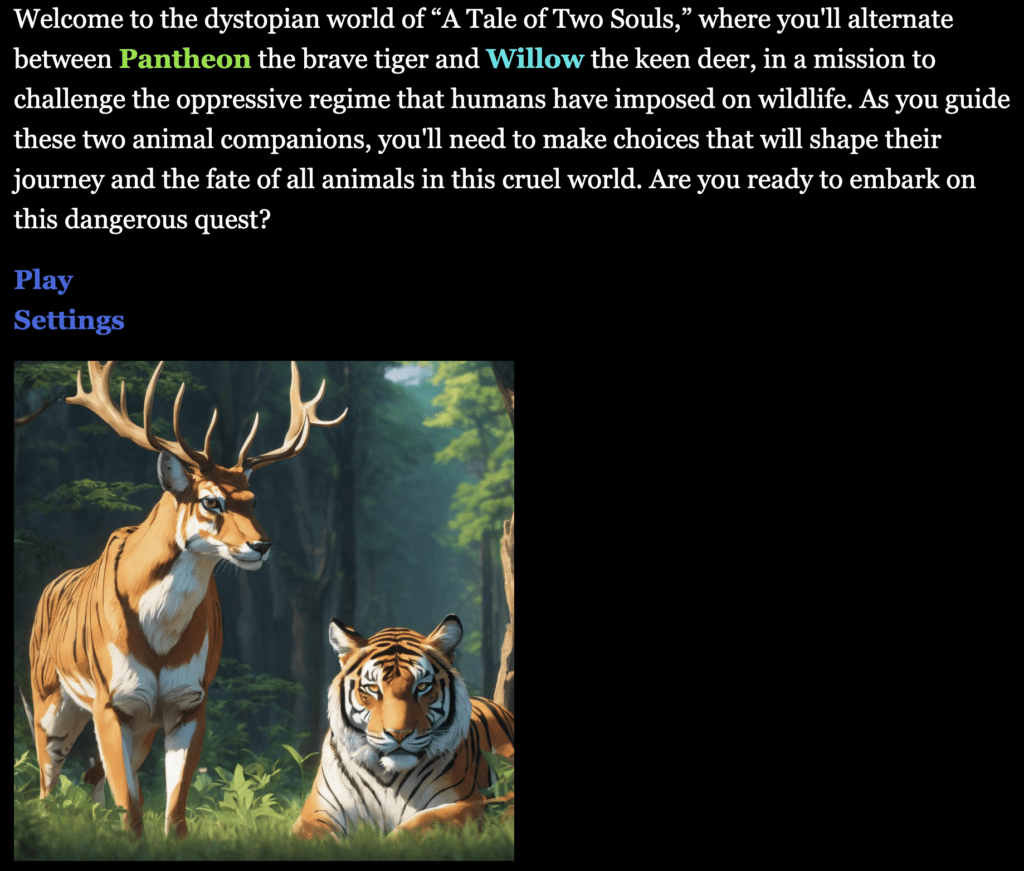
To address Jason’s feedback, I implemented a system to track the characters’ health, starting at 100. When either character’s health reaches 0, it leads to a “Failure” ending and the player has to start over.

Iteration 2: Main Branch (“Success–Revolution” Ending) Completed
| Playtest # | Date | Duration | Playtester | Gender |
| 2 | 10/24/2023 | 7 minutes | Katy | Female |
| 3 | 10/27/2023 | 5 minutes | Emily | Female |
Feedback
In the playtest with Katy, a Stanford student, the feedback was generally positive. Katy appreciated the vivid writing that allowed her to visualize the game world. She found the theme of animals engaging and appreciated the relevance of the game’s issues to modern concerns. Katy also liked the contrast between Pantheon and Willow. She expressed a desire for more world-building information and mentioned that this was her first experience with an interactive fiction game, which she found enjoyable.
Emily, another Stanford student, praised the health point tracking system and was enthusiastic about choosing between the two characters early on. However, she was often confused about where the characters were located and suggested the inclusion of a map with clearly indicated locations to enhance the player’s navigation experience. She also felt that the story was too short and straightforward with only one main branch, and expressed a desire to explore different endings.
Changes Made
In response to the feedback, several changes were implemented before the next iteration of the game. Firstly, I completed the “Success–Exile” and “Success–Coexistence” endings to offer more comprehensive narrative choices.


Since unlocking each of these endings required the player to “collect” certain items and pieces of information, I also added an inventory to help them keep track of what they have collected.

To address Emily’s suggestion, I introduced the option to “View map” at various points in the game, in order to enhance navigation.

Iteration 3: All Branches Completed
| Playtest # | Date | Duration | Playtester | Gender |
| 4 | 11/2/2023 | 12 minutes | Eric | Male |
| 5 | 11/3/2023 (in class) |
15 minutes | Noor | Female |
Feedback
Eric, a UC Berkeley student, stated that he dislikes text-based games in general and preferred more visuals. He got tired of reading a bunch of white text on a black background. He expressed curiosity about the healing mechanism but didn’t want to reach zero health to learn how it worked. He found some options and actions in the game to be counterintuitive, such as the “Gather more information” choice leading to a menu instead of an action. Eric’s overall feeling about the game was that it was “mildly entertaining,” largely due to his appreciation of the puppy character and the straightforward nature of the game. However, he expressed annoyance at certain mechanics, for example, having to click through multiple screens to finish reading the endings.
In contrast, Noor, a Stanford student, had a more positive experience. She appreciated the logical structure of the game and the engaging narrative. However, she was initially confused about the companionship of Pantheon and Willow and suggested making it clearer that they travel together. Noor liked the health point tracking system and the inventory system, as well as the ability to revisit items in the inventory. She also praised the pacing, settings, and the game’s dystopian theme as a metaphor for various real-world issues. On the downside, Noor wished for a longer and more interactive experience with additional character interactions. She expressed a desire for more visuals and effects.
Changes Made
To address both players’ feedback, firstly, I introduced more visuals to enhance the overall atmosphere. I added more images for different locations. I gave all appearances of “Willow” and “Pantheon” specific colors (cyan and lime), making their identities clearer. Furthermore, I assigned each unique location in the story a different background color to enhance the distinction between settings.
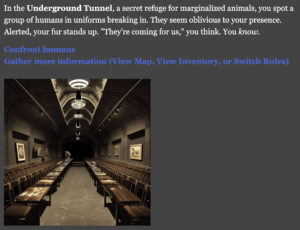
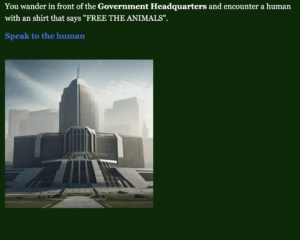
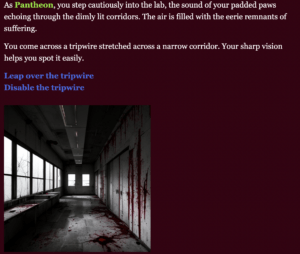
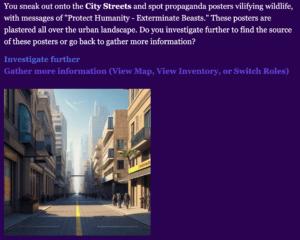
To address Noor’s feedback, I made it evident from the beginning that Pantheon and Willow are companions traveling together.
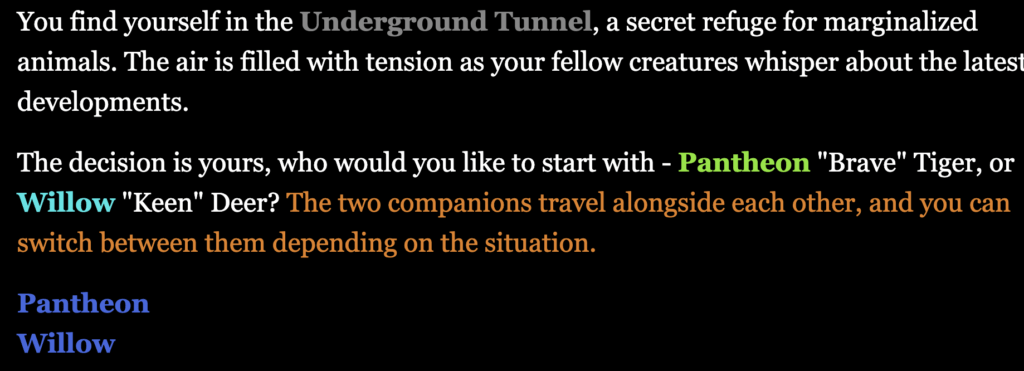
To address Eric’s feedback, I made the endings more satisfying by presenting the paragraphs on the same screen instead of requiring multiple page switches. I changed the “Gather more information” option to “Gather more information (View Map, View Inventory, or Switch Roles)” to address the counterintuitiveness he mentioned. I also clarified Willow’s healing ability and let the player understand the mechanism without having to reach zero health.

I changed the font to a cuter game-like font. Additionally, to provide more world-building as requested by many playtesters (e.g. Chinat, Jason, Elyse, Emily, Katy), I included an explanation of how the current world evolved into the dystopian setting, with key real and hypothetical events.
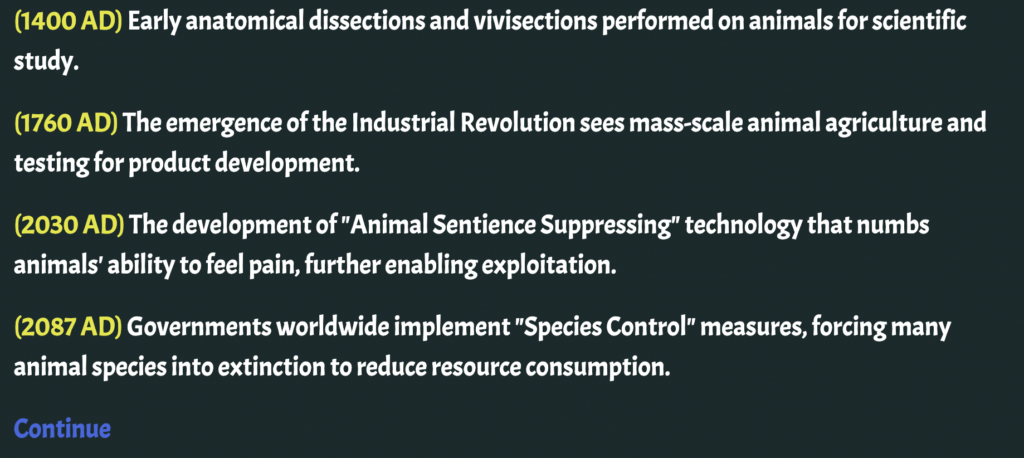
Iteration 4: Visually Enhanced Prototype
| Playtest # | Date | Duration | Playtester | Gender |
| 6 | 11/4/2023 | 15 minutes | Alice | Male |
| 7 | 11/4/2023 | 10 minutes | Jocelyn | Female |
Feedback
Alice, a Stanford student and a creative fiction writer with several published webnovels, appreciated the well-written narrative and the game’s “cute” approach to addressing environmental issues. Alice found the role-switching mechanic “super interesting” and mentioned that it was clear when to use it. However, she was disappointed that when speaking to Lux, she often had only one option to pick, which made the conversation boring. Alice noted that she didn’t expect to reach the ending so quickly and recommended having a picture of the puppy as an improvement. When presented with Pantheon and Willow’s abilities, she didn’t realize that the abilities were clickable, and suggested that I could add text to explicitly encourage players to click on character abilities to learn more.
Jocelyn, another Stanford student, praised the dystopian and suspenseful atmosphere of the game. She enjoyed the storyline, the use of pictures, and the mood-changing screen colors, which enhanced the overall experience. She got stuck at one point as she didn’t know to visit the same location multiple times to collect more items, so she recommended adding hints for players who want to unlock all endings. Her other suggestions included adding sounds for mood enhancement, more images (especially of the puppy), and bringing more emotion into the story. Additionally, Jocelyn proposed exploring storylines where Pantheon and Willow meet different fates to add depth and complexity to the narrative.
Changes Made for the Final Version
In response to the feedback from both playtests, I expanded the story to provide a longer and more immersive experience. I introduced interactions with more animals (the Horse, Panda, and Monkey) to illustrate more examples of animal mistreatment.

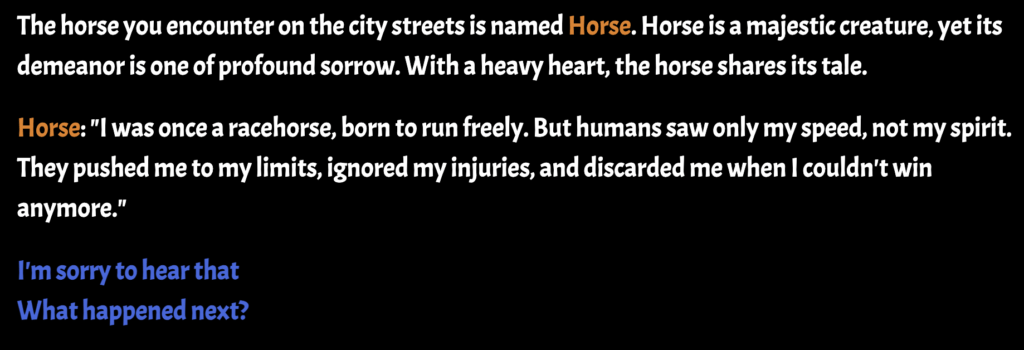

I developed the characters of Pantheon and Willow further, explaining their motivations, backgrounds, and making them distinct beyond their names and abilities.
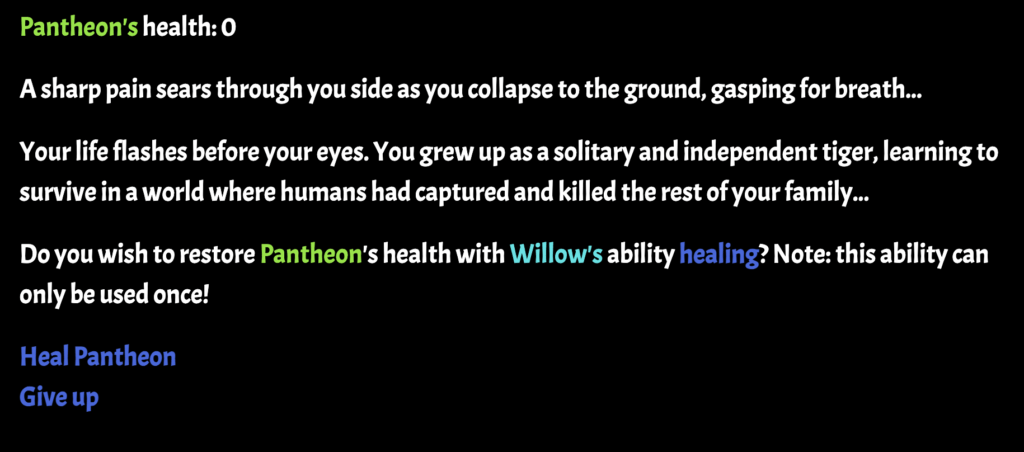

I realized the Almighty Puppy was well-liked by all my playtesters, so I added a picture of the puppy.
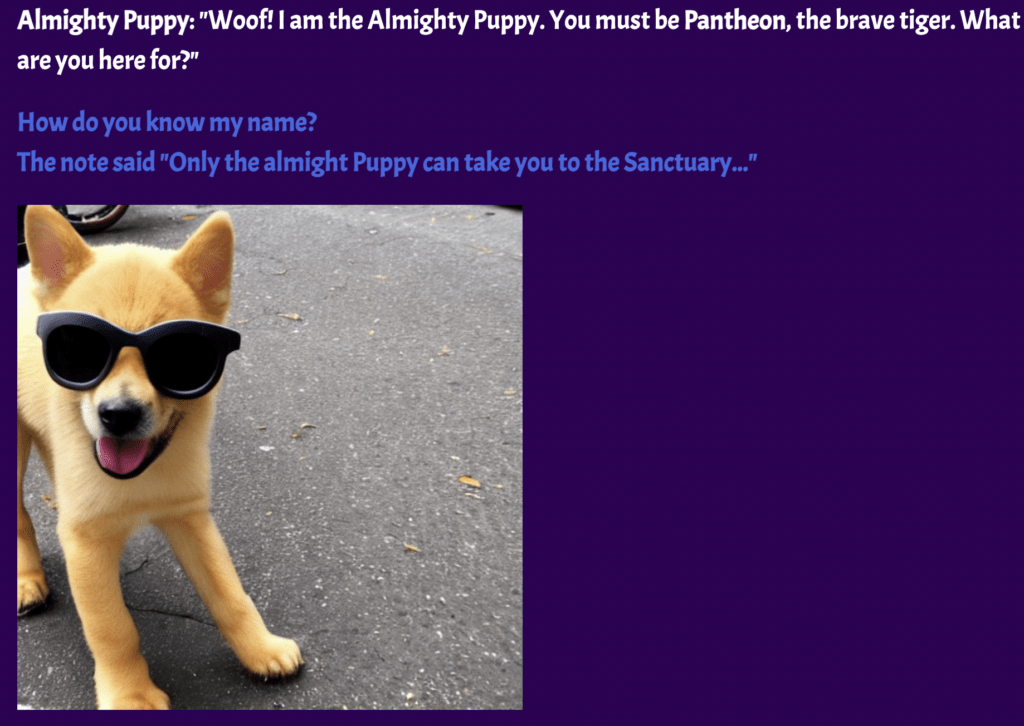
To address Alice’s feedback, I adjusted the dialog with Lux to always provide at least two options, creating the illusion of choice even if it ultimately leads to the same outcome.


Iteration 5: Final Version
Play A Tale of Two Souls at https://kathchen.itch.io/a-tale-of-two-souls
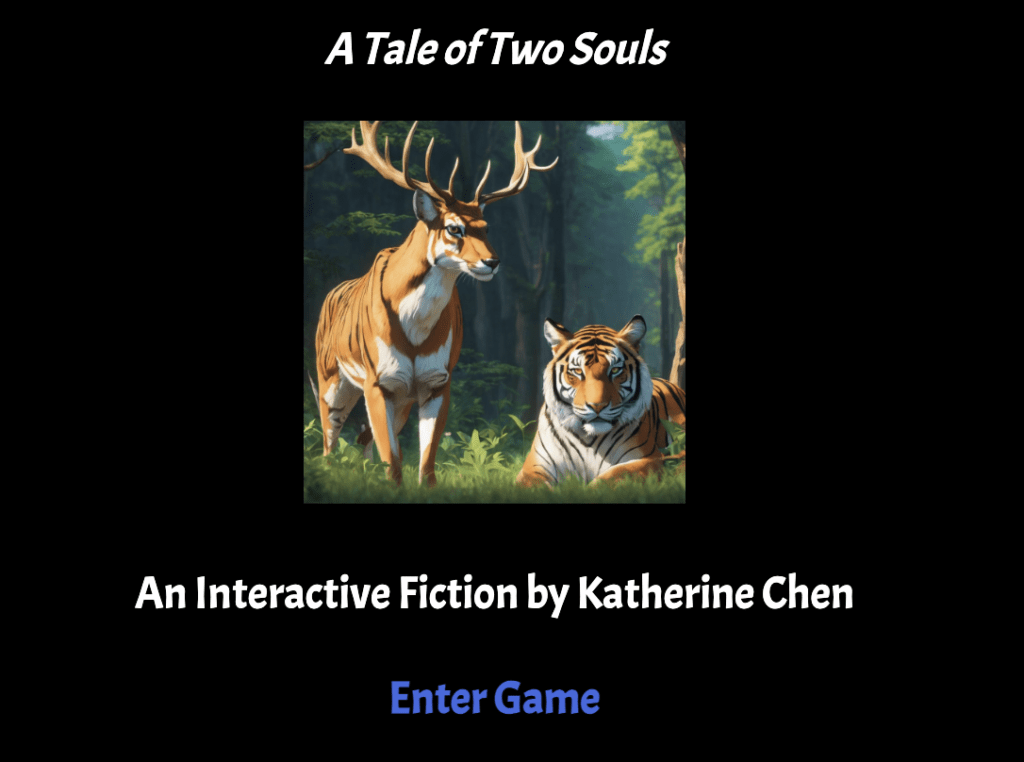
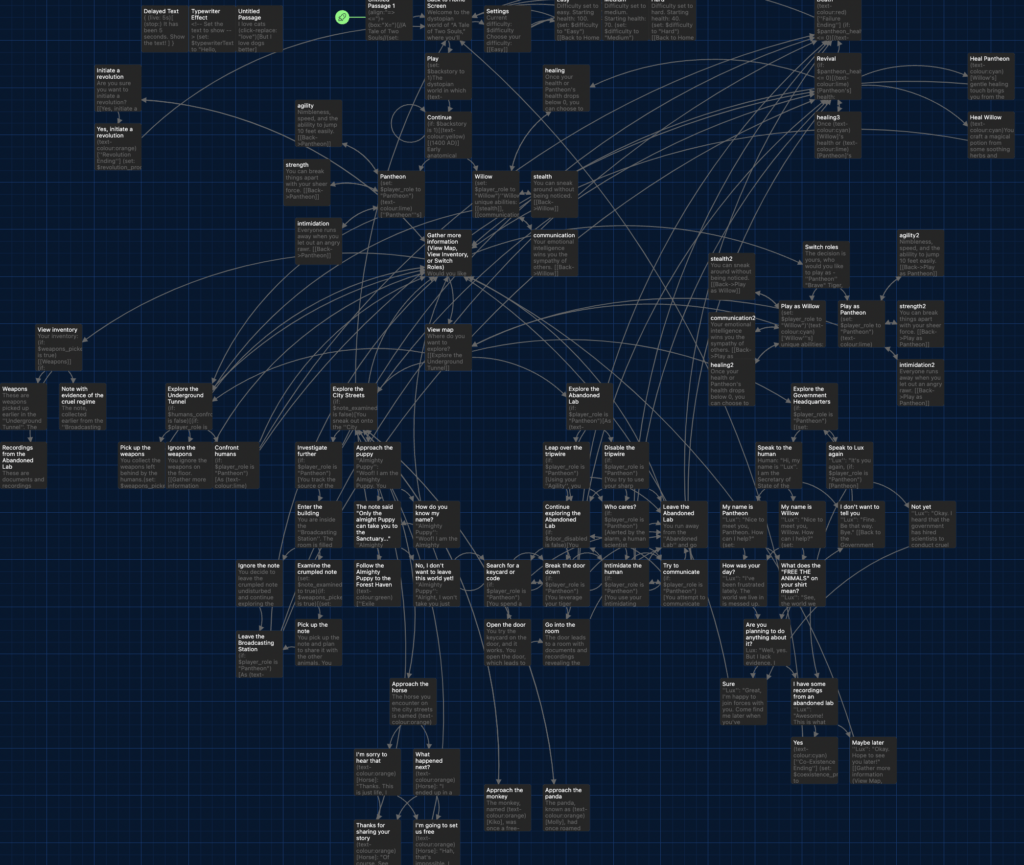
4. Reflection
I’m proud of creating my first-ever interactive fiction! Within two weeks, I created and improved upon a narrative-driven, choice-based adventure game that tackled animal cruelty and environmental imbalance – real world issues that are important to me. I introduced an interesting role-switching mechanic, allowing players to alternate between controlling Pantheon and Willow, which added depth to the gameplay and encouraged players to approach challenges differently. I incorporated a health point tracking system, which added stakes to the game and pressured players to be careful about their choices. I included multiple endings, each offering a unique resolution to the story, increasing replayability, and empowering players to shape the narrative’s outcome. I conducted playtests at different stages of development, gathering feedback from various players to make informed improvements.
My most important takeaway from this project is that iteration is key. My initial prototype was incomplete and very crappy, but with each playtest and iteration, the game improved significantly. I found player feedback to be extremely valuable in identifying areas that needed refinement. I also learned to communicate clearly through text in the game – players should understand how to interact with the game elements, and explanations and hints can be essential for a smoother play experience. Furthermore, I learned a lot more about interactive fictions in general and using Twine.
In the future, I would continue to focus on iterative development. Honestly, I am not satisfied with the narrative yet. I feel like there is still so much room for improvement in terms of digging deeper into the character’s personalities, stories, dialog, and I want to make the players feel even stronger emotions while playing the game. If I had lots of time, I would also hand-draw all the images instead of relying on AI generated art in order to be more original and ensure style consistency across the images. Finally, I want to test with more diverse players outside of Stanford and across a wider age range.
In summary, A Tale of Two Souls has been a fulfilling project, and I’m excited to apply what I learned about creating interactive fictions to my future game development endeavors.


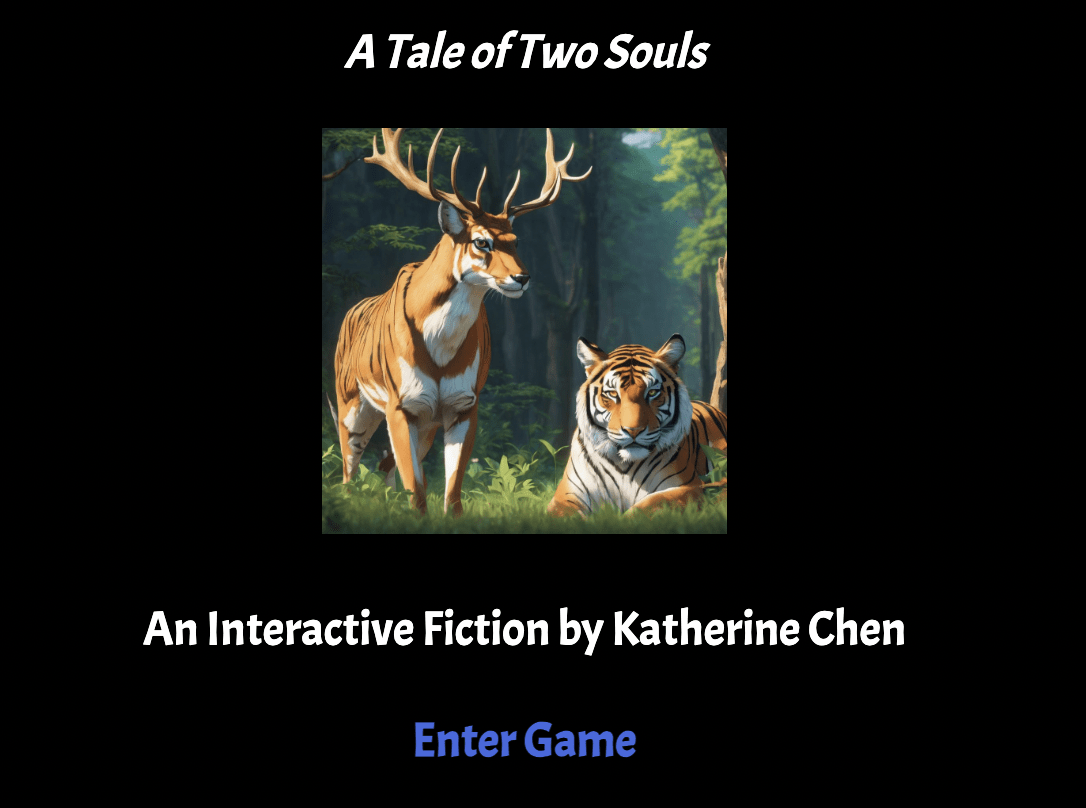
I thought this IF was really cool and set up beautifully. If you wanted to iterate on this project and refine it for P4, I recommend switching your focus to modeling oppression and resistance, and what it takes for revolution. I understand you wanted to showcase animal cruelty but for me this story really spoke about an indigenous population dehumanized by the colonizing force and forced to live in awful conditions. I would make the narrative longer so the user can give Lux the evidence, and continue playing to see how that would turn out. I think all the improvements you put in with color, design and narrative since I last played it were awesome! and improved my playing experience.